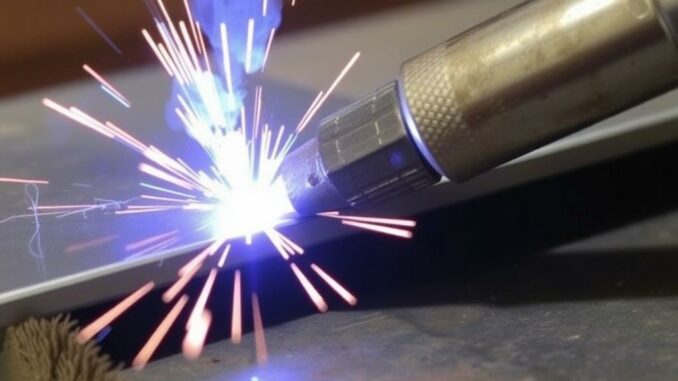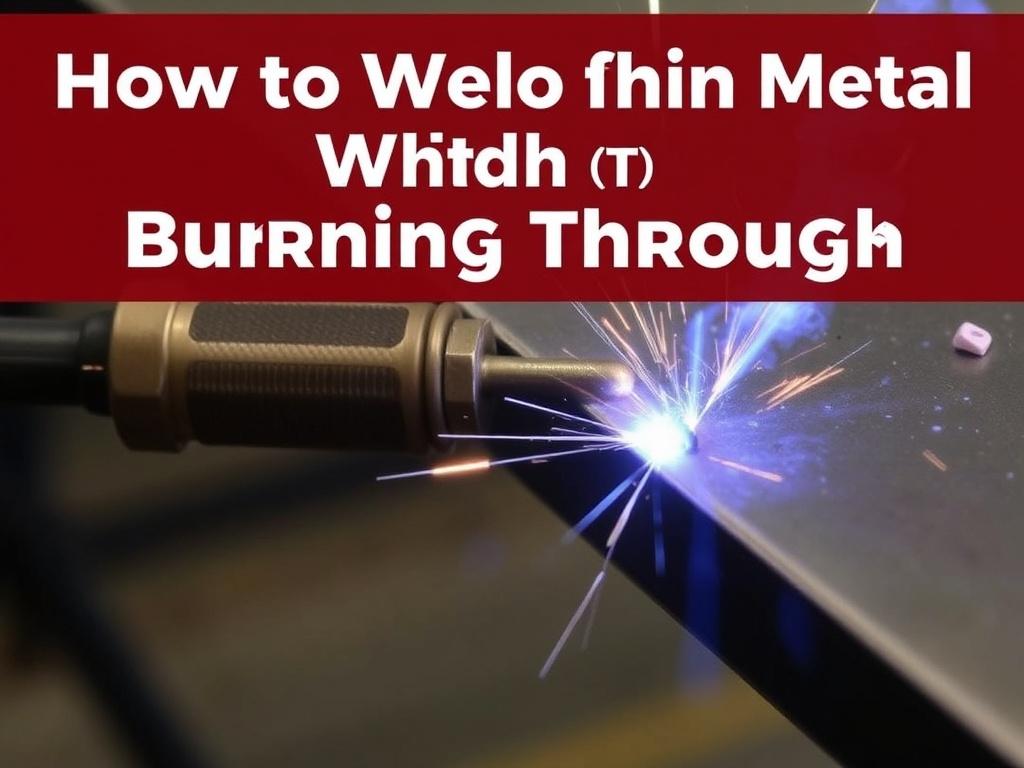
Welding thin metal is a task that requires precision, patience, and a deep understanding of technique. Whether you’re a hobbyist looking to improve your skills or a professional aiming to perfect your craft, the challenge remains the same: how to weld thin metal without burning through it. Burning through thin metal is a common frustration, leading to wasted materials and time. But fear not, this detailed guide will walk you through everything you need to know to master this skill.
Understanding the Challenges of Welding Thin Metal
Before diving into techniques, it’s crucial to understand why welding thin metal is so difficult. Thin metals, typically ranging from 24 gauge (0.5mm) to 18 gauge (1.2mm), have less mass and heat capacity. This makes them prone to warping, distortion, and most importantly, burn-through – where the welder’s heat melts a hole right through the base metal.
When welding thicker metals, there’s a larger ‘heat sink’ effect – the metal absorbs and disperses heat more effectively, lessening the risk of melting through. But with thin metal, the heat can quickly become too much, causing permanent damage. Therefore, learning how to weld thin metal without burning through is an exercise in fine control – controlling heat input, travel speed, and technique.
Common Types of Thin Metals and Their Welding Considerations
Different metals require different approaches when welding thin gauge materials. Understanding your material is the first step to success.
| Metal Type | Common Thickness Range | Welding Considerations |
|---|---|---|
| Steel (Mild Steel, Low Carbon) | 24-18 gauge | Fast travel speed, low amperage welding, avoid excessive filler material. |
| Stainless Steel | 26-18 gauge | Allows moderate heat, use shielding gas suitable for stainless, watch for distortion. |
| Aluminum | 20-18 gauge | Requires specialized techniques like TIG welding, use AC for better cleaning action. |
Because aluminum has high thermal conductivity, it dissipates heat quickly and can be tricky to weld thin sheets. Mild steel is the easiest to start with due to its forgiving nature.
The Essential Tools and Equipment for Welding Thin Metal
Having the right tools is half the battle won. For welding thin metals, you need equipment that offers maximum control over heat and wire feed. This helps prevent you from accidentally melting through the material.
- TIG Welders: TIG (Tungsten Inert Gas) welding is often considered the best for thin metals. It provides fine control of amperage and heat input, producing clean, precise welds.
- MIG Welders with Adjustable Settings: A MIG (Metal Inert Gas) welder with the ability to dial down voltage and wire speed allows beginners and professionals to weld thin metals effectively.
- Welding Helmets with Clear Vision: Good visibility helps maintain accuracy during delicate welds.
- Thin Welding Wire and Electrodes: Using thinner filler rods or wire sizes (such as 0.023” or 0.30mm wire) helps keep the weld bead small and manageable.
- Clamps and Fixtures: Holding thin metal steady and flat during welding reduces warping and potential burn-through.
Preparing Thin Metal Surfaces for Welding
Preparation is a step that cannot be overlooked. Properly preparing the metal surface helps ensure a strong, clean weld and greatly reduces the risk of burning through.
First, clean the metal thoroughly with a wire brush or chemical cleaner to remove dirt, oil, rust, or paint. These contaminants can cause poor weld quality and increase the chances of defects.
Next, consider how the metal pieces fit together. When welding thin metals, butt joints and lap joints are common. Ensure edges are aligned perfectly and avoid large gaps, as excessive gaps can increase the heat input needed, raising the risk of burn-through.
Finally, use clamps to tightly hold the metal in place. Thin metal is prone to warping, and keeping it still helps maintain joint integrity and prevents weak points.
Top Techniques to Avoid Burning Through Thin Metal While Welding
Now that you understand the tools and preparations, let’s get into the nitty-gritty of techniques. The goal when welding thin metal is to use the least heat necessary and to control the weld bead size carefully.
1. Use Low Amperage Settings
One of the most effective ways to avoid burn-through is to use the lowest amperage setting that can maintain a stable arc. This reduces heat input dramatically. For example, when TIG welding thin steel, amperage often ranges between 30 to 75 amps.
With MIG welding, reduce voltage and wire feed speed accordingly. Excess amperage melts through thin metals almost instantly.
2. Increase Travel Speed
Moving the welding torch or gun faster over the joint helps limit heat exposure in one spot. Too slow a travel speed concentrates heat, potentially burning a hole through the metal. However, don’t go so fast that the weld bead is incomplete or porous.
Practice finding the sweet spot. One way to do this is by making test welds on scrap pieces of the same thickness and material.
3. Use Pulse Welding Mode
Pulsed MIG or TIG welding allows the welder to alternate between high and low current settings rapidly. This pulsing reduces heat buildup and allows thin metal to cool between pulses, significantly reducing the chance of burn-through.
This technique is particularly useful for hobbyists without full TIG welding capabilities, as many mid-range MIG welders come equipped with pulse modes.
4. Employ a Stringer Bead Instead of a Weave
While weaving can help fill wider joints on thicker metals, thin metal requires smaller, precise weld beads. A stringer bead is a straight, narrow weld that minimizes heat concentration and distortion.
5. Consider Backing Bars and Copper Blocks
Using a copper backing bar or block behind the joint acts as a heat sink. Copper absorbs heat extremely well and prevents melt-through from the backside of the weld. This technique is especially effective when welding extremely thin metals, such as automotive panels.
6. Use Proper Shielding Gas
Shielding gas composition can affect heat input and weld quality. For MIG welding thin steel, a mixture of argon and CO2 (such as 75/25) is common, while TIG welding uses pure argon or argon-helium mixes. The right gas protects the weld puddle, reduces oxidation, and helps maintain arc stability.
Step-By-Step Guide to Welding Thin Metal Without Burning Through

If you’re ready to try welding thin metal yourself, follow this detailed procedure for the best results:
- Prepare Your Workspace: Ensure you have adequate ventilation, protection gear, and all tools ready.
- Clean the Metal: Use a wire brush or chemical cleaner to ensure rust and grease-free surfaces.
- Fit and Clamp: Arrange your metal pieces carefully, aligning edges perfectly, and secure them tightly with clamps.
- Select Welder Settings: For TIG welding, set amperage low (30-50 amps for 18 gauge steel). For MIG, lower voltage and wire speed.
- Choose the Right Filler Material: Use thin wire or rod, matching the metal type and thickness.
- Test on Scrap: Practice your bead on scrap metal of the same gauge, adjusting settings as needed.
- Weld with Controlled Movements: Use a stringer bead at steady travel speed, watching your heat input carefully.
- Cool Down: Allow the metal to cool naturally to reduce stress and warping. Avoid rapid cooling methods which can cause cracking.
Advanced Tips to Perfect Welding Thin Sheet Metal
Once you’re comfortable with basic techniques, adopting advanced practices can improve your results further.
1. Use Foot Pedal Control on TIG Welders
Foot pedal control gives you on-the-fly control of amperage, allowing you to “feather” the heat during tricky parts of the weld. This is invaluable for beginners and pros alike.
2. Weld in Short Sections
Instead of running one long bead, weld in short bursts and let the metal cool briefly. This helps manage heat buildup over larger weld areas.
3. Optimize Electrode Angle and Distance
Keep the tungsten electrode about 1/8” from the metal and angle the torch to direct heat away from burn-prone edges. Angle typically between 10 and 15 degrees in the direction of travel.
4. Use Preheating Sparingly
While preheating thick metals helps, on thin metals, it can increase the risk of burn-through if not carefully controlled. Use gentle preheat only when necessary.
Common Mistakes and How to Avoid Them
Even experienced welders occasionally make mistakes when working with thin metals. Knowing what common pitfalls exist will help you sidestep them.
| Common Mistake | Why It Happens | How to Avoid |
|---|---|---|
| Excessive Heat Input Burn-through | Wrong amperage or slow travel speed | Adjust settings, move faster, use pulse welding |
| Poor Weld Penetration | Too low heat or incorrect filler usage | Ensure settings are balanced, use proper filler material |
| Warping and Distortion | Uneven heat distribution or lack of clamps | Use clamps, weld short sections, cool gradually |
| Contaminated Welds | Dirty surfaces or improper shielding gas | Clean surfaces thoroughly, check gas flow and purity |
Real-Life Examples: How Professionals Weld Thin Metals
To inspire you, here are anecdotes from professional welders who specialize in thin metal fabrication:
- Auto Body Repairs: Professionals use TIG welding on 24-26 gauge sheet steel using pulse welding mode to repair dents and holes without warping body panels. They use copper backing bars and quick tack welds to distribute heat.
- Artistic Metalwork: Sculptors often weld thin stainless steel or aluminum sheets using TIG welding, relying heavily on foot pedal control and gas mixtures to maintain precise heat balance and aesthetic welds.
- HVAC Duct Work: Thin galvanized steel ducts are welded using MIG welding with low wire feed and travel speed adjustments, striking a balance between speed and heat control to maintain duct integrity.
Summary: Your Blueprint to Successful Thin Metal Welding
Welding thin metal without burning through requires a mix of preparation, proper equipment, and practiced technique. Key takeaways include:
- Understand the challenges specific to the metal type and thickness.
- Use the lowest practical heat settings—low amperage, voltage, and wire feed speed.
- Maintain steady, fast enough travel speed to avoid excessive heat buildup.
- Prepare materials meticulously, keeping surfaces clean and properly clamped.
- Use pulse welding modes and backing bars where appropriate to control heat.
- Practice consistently on scrap before committing to your project piece.
By following the steps and tips outlined in this comprehensive guide, you’ll gain confidence and skill, transforming a frustrating task into a satisfying and precise craft. Whether you’re welding automotive panels, delicate art pieces, or lightweight structures, mastering how to weld thin metal without burning through will open up new possibilities in your welding journey.
